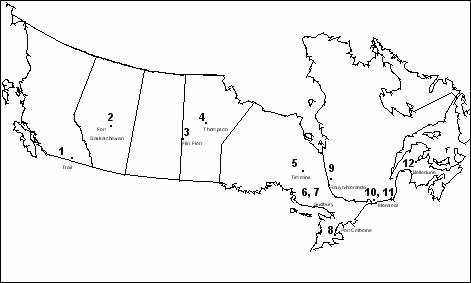Base Metals Smelters
The Canadian base metals smelting and refining sector produces cobalt, copper, lead, nickel and zinc, as well as various co-product metals such as gold, silver, indium, germanium, cadmium, bismuth and selenium. Primary processing generally produces metals from ore concentrates, while secondary processing produces metals from recyclable materials which include post-consumer electronic components, metal parts, bars, turnings, sheets, and scrap wire.
Environmental Impact on Air Quality
The base metals smelting sector releases the following substances declared toxic under the Canadian Environmental Protection Act,1999 (CEPA 1999):
- Sulphur Dioxide (SO2)
- Particulate Matter containing metals that are released in emissions from copper smelters or refineries, or from both, as well as particulate matter containing metals that are released in emissions from zinc plants
- Respirable Particulate Matter less than or equal to 10 microns (PM10)
- Heavy Metals such as lead, mercury, inorganic arsenic compounds, inorganic cadmium compounds
- Oxidic, Sulphidic, and Soluble Inorganic Nickel Compounds
- Dioxins and Furans
Other pollutants associated with this industry are:
- Acidic compounds (e.g. Hydrogen Chloride (HCl), Hydrogen Fluoride (HF), Sulphuric Acid (H2SO4))
- Ammonia (NH3)
- Greenhouse Gases (e.g. Carbon Dioxide (CO2), Carbon Monoxide(CO))
Air emissions from this sector are caused by pyrometallurgical, hydrometallurgical and vapo-metallurgical processing methods, whereby pollutants are released as gases, vapour species, or particulate matter. These emissions require capture and disposal or are to be recycled back to the process.
The following table shows the percentage of Canadian emissions released from the base metals smelting sector in 2002.
| 2002 Emissions | ||||
| Substance | Units | Base Metals Smelting* | Canadian Total** | % emissions |
| Arsenic | tonnes | 153 | 201 | 76% |
| Cadmium | tonnes | 36 | 40 | 90% |
| Lead | tonnes | 354 | 736 | 48% |
| Mercury | kg | 1,724 | 5,824 | 30% |
| Nickel | tonnes | 258 | 475 | 54% |
| Total Particulate Matter | tonnes | 7,484 | 227,900 | 3% |
| Sulphur Dioxide | tonnes | 734,090 | 1,978,935 | 37% |
* Rubinoff Environmental, Pollution Prevention and Pollution Control Initiatives in the Base Metals Smelting and Refining Sector, February 2004.
** Environment Canada, National Pollutant Release Inventory (NPRI), 2002.
Canadian Context
Shown below are the twelve (12) base metals metallurgical complexes in operation in Canada, located in British Columbia (1), Alberta (1), Manitoba (2), Ontario (4), Quebec (3) and New Brunswick (1).

| Province | Company | Site/Location | Facility | Map |
| BC | Teck Cominco | Trail | Lead Plant, Zinc Plant | 1 |
| AB | Corefco/Sherritt | Fort Saskatchewan | Nickel & Cobalt Refinery | 2 |
| MB | Hudson Bay | Flin Flon | Copper Smelter, Zinc Plant | 3 |
| Inco | Thompson | Nickel Smelter, Nickel Refinery | 4 | |
| ON | Falconbridge | Kidd/Timmins | Kidd/TimminsCopper Smelter, Copper Refinery, Zinc Plant | 5 |
| Falconbridge | Sudbury | Nickel/Copper Smelter | 6 | |
| Inco | Copper Cliff/Sudbury | Nickel Copper Smelter, Copper Refinery, Nickel Refinery | 7 | |
| Inco | Port Colborne | Cobalt Refinery | 8 | |
| QC | Noranda | Horne/Rouyn-Noranda | Copper Smelter | 9 |
| Noranda | CEZ/Valleyfield | Zinc Plant | 10 | |
| Noranda | CCR/Montréal | Copper Refinery | 11 | |
| NB | Noranda | Brunswick/Belledune | Lead Plant | 12 |
Emission Management Practices and Regulations
Federal Government
- The Canadian Environmental Protection Act, 1999 (CEPA 1999)
- Secondary Lead Smelter Release Regulations (SLSRR)
- National Pollutant Release Inventory (NPRI)
- National Ambient Air Quality Objectives (NAAQOs)
- Management of Toxic Substances, Environment Canada
- Minerals and Metals Branch, Environment Canada
Canadian Council of Ministers of the Environment (CCME)
- Canada-wide Standards (CWSs) for Particulate Matter (PM) and Ozone
- Canada-wide Standard (CWSs) for Mercury
Provincial Governments
British Columbia:
Alberta:
Substance Release Regulation (Alta. Reg. 124/93)
Alberta Ambient Air Quality Guidelines (pdf)
Manitoba:
Ontario:
Clean Air Orders for Inco and Falconbridge (2002)
Air Pollution Regulation (Environmental Protection Act R.R.O 1990, Reg. 346)
Point of Impingement Standards, Point of Impingement Guidelines and Ambient Air Quality Criteria (AAQCs) (pdf)
Quebec:
Regulation Respecting the Quality of the Atmosphere R.R.Q.A. 1981, c. Q-2, r.20
Règlement sur les attestations d'assainissement en milieu industriel (RAMMI)
New Brunswick:
Municipal Governments
By-Law 90 (pdf)
History
By-products of the smelting process include metals, metal compounds, particulate matter and sulphur dioxide. The generation of these substances is inherent to the processes used, but prevention and control of emissions can and should be practiced.
Base metals smelting using contemporary processes began in the late 19th century. Emissions are being significantly reduced due to improved process technology, prevention and control methods, and environmental awareness.
It is forecast that by 2015, the sector will meet standards based on world leading best available techniques for pollution prevention and control, as proposed in Environment Canada's Proposed Pollution Prevention Plan Notice, published in Part I of the Canada Gazette in September 2004.
Take Action
Consideration should be given to the application of Best Available Techniques (BAT) for the prevention and control of emissions in the smelting process. Whenever possible, prevention of substance formation should be the preferred option. Process technology is constantly being improved to reduce the generation and release of emissions.
In Canada, government, industry and public interest groups actively participate in multi-stakeholder consultations to improve the environmental performance of the base metals smelting sector.





